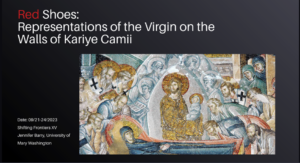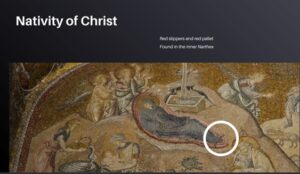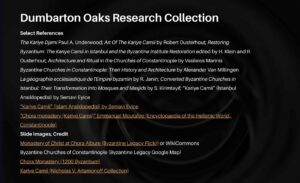Unfolding the Theotokos
Jennifer Barry
The International Catacomb Society Shohet Fellowship for the 2022-2023 grant year supported Jennifer Barry in conducting research and making significant progress on her second monograph, Gender Violence in Late Antiquity: Male Fantasies and the Christian Imagination. The culmination of this research resulted in a completed chapter and a conference presentation titled "Red Shoes: Representations of the Virgin on the Walls of Kariye Camii” at the XV Shifting Frontiers Conference held at the University of California, Santa Barbara, from September 21 to 24, 2023.
Project Summary
During the grant period, Prof. Barry, Associate Professor of Religious Studies at the University of Mary Washington, was able to complete the final research for chapter two of her current book project on Gender Violence in Late Antiquity, titled "Unfolding the Theotokos." This chapter explores the literary foundations that shaped the perception of the Virgin Mary's reproductive body in apocryphal texts of the third and fourth centuries. Additionally, it delves into how these perceptions later became central to Christological controversies and the visual representations of Mary's body in material culture. The primary focus of the chapter is on analyzing various depictions of Mary's body and corresponding colors as well as objects associated with her status as a Virgin preserved in Byzantine structures such as the Kariye Camii in Istanbul, Turkey.
The corresponding conference paper addressed the topic of late Romans in interconnected and uncentered worlds by exploring the use of red shoes in the scenes depicted on the walls of the Kariye Camii (also known as the Chora Church). By focusing on glimpses of ruby slippers throughout the church, Barry argued that pilgrims are taken on an adventure through the life cycle of the Virgin, allowing them to imagine both orthodox and apocryphal representations of Mary's brief footing on the earth. The well-received paper ultimately critically examined the multiple meanings of the color red in footwear across the late ancient world to explore how the color of her shoes might function in the Marian
Description of the Larger Book Project - "Gendered Violence in Late Antiquity"
The larger book project, Gendered Violence in Late Antiquity, seeks to demonstrate how late ancient texts actively condone and perpetuate violence against women to maintain Christian orthodoxy. The project adopts a multifaceted approach, combining literary theory, gender studies, and historical analysis to closely examine ancient stories about women as fantastical literature for a Christian audience. The book critically engages with the erasure or silencing of women's experiences of violence in the ancient world and aims to uncover the processes by which vulnerable bodies, often enslaved and unnamed, are used to think with in the broader Christian imagination.
The book's central argument highlights a connection between theological reasoning, philosophical conclusions, and gender-based violence. It explores how episodes of violence, often considered necessary evils in hagiographical writing, are preserved and even promoted in these texts. Barry uses the framework of ancient dream theory to elucidate the difference between contemporary and ancient interpretations of Christian male fantasies, ultimately revealing a sanctioned genre that normalizes gender-based violence in the late ancient Christian imagination.
Outcomes
The research supported by the International Catacomb Society Shohet Fellowship has significantly contributed to the advancement of Barry’s work on gender-based violence in late antiquity and its intersection with Christian narratives. With the generous support of the Shohet Barry was able to conduct focused research, which required physical access to the Image Collections and Fieldwork archive at the Dumbarton Oaks Library in Washington, DC. Specifically, she focused on field notes and early commentaries on frescoes and mosaics by Thomas Whittmore and Paul Atkins Underwood from 1947-1968. She will also travel to Venice and Ravenna, Italy to conduct comparative research with a special focus on the color and use of red shoes in other contemporaneous images. The chapter and adjacent article will likely be published sometime in 2024-2025.



